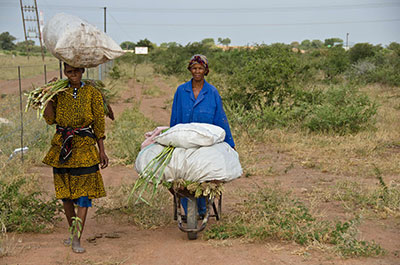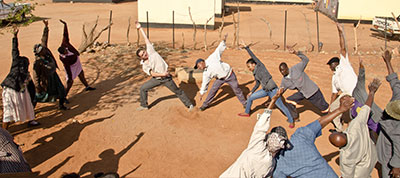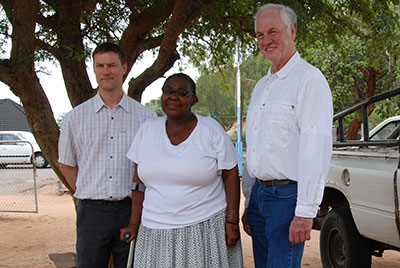
When chiropractor Dr. Becky Carpenter heard about World Spine Care (WSC) as a student at Canadian Memorial Chiropractic College (CMCC) in Toronto, she knew she had to volunteer.
When chiropractor Dr. Becky Carpenter heard about World Spine Care (WSC) as a student at Canadian Memorial Chiropractic College (CMCC) in Toronto, she knew she had to volunteer.
 |
|
| Photos by Dr. Geoff Outerbridge Advertisement
|
She graduated from CMCC in June 2012, and two months later, she set out for Botswana in Africa to help WSC set up a clinic in the rural village of Shoshong. It was one of the most eye-opening six weeks of her life. The Shoshong project is WSC’s flagship program that will develop models of care for future WSC clinics to adopt.
“Coming back to Canada, especially being a new grad, it was such a huge learning experience in hands-on treatment that I would never have received in Canada,” says Carpenter.
Dr. Doug Brandvold, of Rossland, B.C., also volunteered for WSC in Botswana – twice. He sees the initiative as creating opportunities to strive for professional humanitarian service and training.
“The holistic and health promotion aspects of our profession mesh well with the possibilities of health care in poorer countries,” Brandvold says. “Musculoskeletal-based, functional mobility problems of all kinds are crying out for better triage and management in all parts of the world.”
Since its inception in 2008, WSC continues to inspire and mobilize chiropractors and health-care practitioners around the world to help make spinal care accessible to poorer communities in developing countries.
Founded by Canadian-born chiropractor and neurologist Dr. Scott Haldeman, WSC’s vision is the establishment of a multidisciplinary, effective and sustainable model of care for musculoskeletal disorders, particularly for communities where spinal care is practically non-existent. Since its establishment, WSC has focused most of its efforts in Botswana, where it now operates out of two clinics: inside the Mahalapye District Hospital, and a stand-alone clinic in the village of Shoshong. For nearly three years, Botswana has been the development hub for WSC initiatives – from establishing models of care and building local capacity to creating outcome measures.
Quebec-based chiropractor Dr. Geoff Outerbridge is the clinical director for WSC who oversaw the Botswana pilot project in Mahalapye and Shoshong. Coming from a family of missionaries, Outerbridge willingly takes on the task. For two years since 2011, he and his family (wife Sophie and son Liam) lived in Botswana, overseeing the Mahalapye hospital clinic, building the Shoshong clinic from the ground up, developing research programs, training volunteers and educating the community about spinal health, among other things.
“Everything about Scott’s vision resonated with me – evidence-based, sustainable, interprofessional care for those in need,” Outerbridge recalls. “Here was the opportunity to impact so many more people by creating multiple clinics that would be the training ground for so many future chiropractors and possibly influence the future direction of chiropractic and its expansion around the world.”
Although actively spearheaded and supported by chiropractors and chiropractic institutions, WSC’s vision of creating greater global access to musculoskeletal care requires interprofessional collaboration – chiropractors working side-by-side and consulting with other health-care practitioners like surgeons, physiotherapists, rheumatologists, orthopedic specialists and other spine care specialists.
This collaboration not only ensures effective and efficient care for WSC communities but also sets the stage for the chiropractic profession’s integration into the health-care system on a global scale.
“By introducing chiropractic to health-care systems that have not incorporated spinal care in any way, we are establishing chiropractic as an integral, fully accepted part of the health-care teams,” Outerbridge says.
“Our interprofessional team involves leading surgeons, physiotherapists and others in the spine care world. We all have an amazing relationship that is spreading the value of interprofessional collaboration to all these communities.”
Since the Mahalapye and Shoshong clinics opened, more than 1,000 patients have received care from more than a dozen volunteer chiropractors and health-care professionals around the world.
The experience of flying across the continent to offer care for those who need it the most is as personally rewarding as it is professionally gratifying. Not only are volunteers encouraged to learn as much of the local language as they can, but they have also been faced with interesting and sometimes rare conditions that would pique the interest of most scientific practitioners.
“The volunteers deal with more unique and interesting pathologies in a month than I ever experienced in 10 years of practice,” says Outerbridge.
“In our clinics we have seen Paget’s, abdominal aortic aneurisms, Pott’s spine, septic arthritis, DISH (diffuse idiopathic skeletal hyperostosis), odontoid fracture, Blount’s diseases, kidney infections, hydronephritis, Sprengel’s deformity, neurogenic claudication, situs inversus… and much more.”
Proper diagnosis and treatment of these conditions are crucial. Without the availability of spinal care specialists and appropriate model of care, these patients would simply be sent home from the hospital with pain medications. WSC’s team of multidisciplinary spinal care specialists is hoping to change this paradigm.
Burden of disease
It is a known fact in the health-care world that low-back pain affects up to 85 per cent of people at one point in their lives. Yet, there has never been any established model of care for spinal disorders, particularly in the developing world, says Haldeman. It’s a realization that motivated the establishment of WSC and its vision of creating a model of care that can be instituted in poor communities and effect meaningful changes to the disability landscape.
 |
|
“We now know, through the Global Burden of Disease, (back pain) is the number one cause of disability,” says Haldeman.
In 2012, the Global Burden of Disease report, published in the medical journal The Lancet, recognized low back pain as the leading cause of disability worldwide. The report cites spinal disorders as contributing more to the global burden of disease than HIV/AIDS, malaria, stroke, lung and breast cancer, diabetes, traffic injuries, lower respiratory infections, Alzheimer’s and depression.
In developed countries, such as Canada, access to health care and social services is almost a matter-of-fact. When a worker suffers from musculoskeletal pain, for instance, systems are in place to offer social and health-care assistance to support the worker – and his family – through the recovery process.
The consequences of a musculoskeletal disease in a developing nation, however, can be life changing. A debilitating back pain for a sole breadwinner could mean an entire family going hungry.
The burden of spinal pain has a bigger impact in developing countries compared to westernized nations, says Dr. Deborah Kopansky-Giles, Toronto-based chiropractor and clinician scientist on staff in the department of family and community medicine at St. Michael’s Hospital. She also volunteers for WSC in the research team.
“It’s not just saying, ‘Oh, I can’t go to work for a week but I’ve got social services that’s going to take care of me.’ It is actually critical for people to have healthy backs and necks, to be healthy physically, in those rural impoverished areas where people are hugely disadvantaged and they don’t have access to care,” she explains.
“That person who’s unable to work can’t feed his family, can’t support his family, and can’t contribute to the whole village or town. So the whole burden amplifies itself.”
This makes the work of WSC even more crucial, particularly in parts of the world where access to social services and health care is a challenge.
“Governments are starting to understand the global burden of spinal pain,” says Outerbridge. “It’s reached a point now where spinal pain is a more significant contributor to the global burden of disease than any infectious disease – second only to Ischemic heart disease.”
Sustainability
Outerbridge and his family returned to their home in Quebec last September. He still travels to Botswana occasionally to offer ongoing support in the clinics. Another volunteer chiropractor, Dr. Tim Ford, from South Africa, has taken over as clinic coordinator for both the Shoshong and Mahalapye clinics.
 |
|
As clinic director, Outerbridge will also be overseeing new projects in other parts of the world where WSC has since forged agreements with the respective governments to set up spinal care clinics. Next stop: Tanzania and the Dominican Republic.
Sustainability is key to the success of every WSC clinic. From the moment an agreement is forged with the local government to set up a clinic, an exit strategy is put in place. This ensures the clinic continues to operate efficiently, long after WSC volunteers have left and gone on to new projects.
Building local capacity – training frontline health workers, providing opportunities for students to become chiropractors or spine care specialists, engaging and educating the community – begins from day one.
“We teach people how to take care of their spines (and teach) exercise programs,” says Kopansky-Giles. “And we’re starting this train the trainer program where we’re training people how to teach people to do exercise.”
Patient education on spinal care and prevention is an important aspect of sustainability efforts to improve the health in every WSC community. In addition, frontline health-care workers are taught spinal first aid and triage for spinal disorders.
The local government’s support is also critical in ensuring the sustainability of WSC clinics. In Botswana, the government agrees to support the cost of travel and living expenses for local students who have been granted scholarships to a chiropractic school. The first WSC scholar from Botswana is currently attending Palmer College in Davenport, Iowa. A second student will attend the CMCC next fall on scholarship.
Research and outcome measures are also essential to sustainability. Now that the Shoshong pilot project has been established and is going into its second year of operation, the process of developing outcome measures that can be applied throughout all WSC locations, as well as efficacy research, have begun.
“We’re looking at an epidemiology research project right now to see if, after five years, have we made an impact on the burden of spine conditions in Shoshong, for example? Have we made a difference?” says Kopansky-Giles.
Data collection is also an ongoing effort. The goal is to have data from all WSC sites fed into a central database, building a wealth of information that can aid future research, she adds.
All these initiatives are key to creating sustainable sites that can operate efficiently and deliver effective care to the community long after WSC has gone. To fulfill its vision to provide access to musculoskeletal care to underserved communities around the world, WSC needs to be able to turn over management of the clinics to the local entities – government, private organizations, local non-profit groups – with confidence that they are able to carry on the work. This allows WSC to serve new communities every few years and gradually create a network of WSC clinics around the world.
“We have an exit strategy for every country before we go in,” says Outerbridge.
Team effort
Aside from providing access to spinal care, WSC clinics are a showcase of interprofessional collaboration at its finest, and proof of what health-care professionals can achieve when working towards a unified cause.
WSC’s team of highly trained volunteers, specialized in the treatment and management of spinal conditions, offers an alternative to the old, ineffective and unsustainable norm of prescription medication as the first line of treatment for spinal conditions. Hospitals and primary care doctors can now refer patients to WSC clinics where they can receive more efficient, evidence-based care.
Each WSC clinic is led by a primary spine care clinician who manages people coming in with spine-related conditions. This spine care clinician could be a chiropractor or physiotherapist with advanced training on spine care, Kopansky-Giles explains.
“(The spine care clinicians) are going to screen people and they are going to stratify people into those that can be managed conservatively – with manipulation and mobilization exercise – and (those) who need an orthopaedic consult or people who need a rheumatological consult,” she says.
WSC works with volunteer spine surgeons to perform spine surgery for those who need it. Rheumatology experts are also brought in for patients who need this type of care.
Collaboration comes a little easier with the support of major spine care societies. Because there has never been anything like it before, WSC now enjoys the support of every major spine care organization in the world, including the North American Spine Society, Spine Society of Europe, International Society for the Study of the Lumbar Spine, Canadian Spine Society, South African Spine Society, the World Federation of Chiropractic and the Canadian Chiropractic Association.
In addition, educational institutions around the world have also come onboard by either providing scholarships to students from a WSC community or becoming a collaborating centre for research projects. These schools include Palmer College, University of Hawaii, University of South Denmark, University of South Florida and CMCC.
Haldeman says these organizations and health-care professionals coming together to help address this global health issue is an indication that WSC is an undertaking whose time has come.
“We’ve reached a point where chiropractors are now part of the spine care multidisciplinary team, and the fact that there has been a strong, active participation by the chiropractic profession in World Spine Care has not been perceived as a negative. As a matter of fact, it’s being perceived as a positive by the medical communities,” Haldeman says.
“Cooperation in multidisciplinary teams, the idea that none of us have the answer and we have to work on this better and that there are a lot of people who aren’t getting appropriate care – it just all came together to make this work.”
Crowdsourcing
WSC plans to break ground and open new clinics in Tanzania and the Dominican Republic this year. The memorandum of agreement has been signed with the government of Tanzania. Volunteers are ready to fly out at a moment’s notice. India is not far behind.
The organization is going full blast on fundraising to ensure the project goes on and the volunteers are supported on the ground without a hitch.
WSC receives grants from philanthropic groups but, Kopansky-Giles says, more funds are needed to ensure a sustainable and continuous program.
This year, WSC plans to launch a marketing campaign to increase awareness about its initiatives worldwide, appeal for donations and encourage more chiropractors and other health-care professionals to volunteer.
“This is what we do. This is how we make an impact on the world,” says Kopansky-Giles. “We’re really hoping that will appeal to chiropractors and physiotherapists to say, ‘Listen, now you’re actually supporting something that is exactly what you contribute to the world.’ I think it will be a lot more meaningful for people.”
The aim for fundraising is somewhat of a crowdsourcing model. The hope is to get chiropractors and other donors to become members and commit to donate a certain amount – as low as $50 a year.
Since the success of the Shoshong and Mahalapye clinics, WSC has received numerous requests from several countries to come and build clinics, according to Haldeman.
“The only restriction preventing us from going into more places is funds,” Haldeman says.
“If this works – and it seems to be working very well – we may make a serious impact. Chiropractors, so far, are taking a major role in this whole project, which I think is very commendable and will show the world that chiropractors really care.”
Mari-Len De Guzman is the editor of Canadian Chiropractor and Massage Therapy Canada magazine. She can be contacted at mdeguzman@annexweb.com.
Print this page